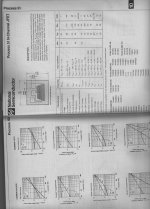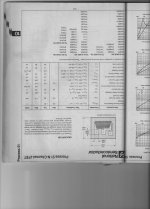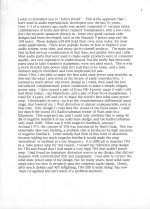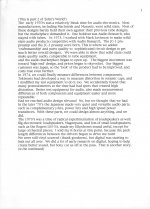Adding a lot of extra parts to compensate for problems that could have been eliminated by using better parts and materials in the first place is less than optimum.
This sound pretty silly to me.
I do not think so. We may often find almost hidden local HF oscillations in over-complexed power amplifiers.
I do not think so. We may often find almost hidden local HF oscillations in over-complexed power amplifiers.
These lines of thought don't follow at all. John said nothing about parasitic oscillations, I think he alludes to a pile of cheap components to compensate for not using $100 teflon capacitors or other blessed components.
I do not think so. We may often find almost hidden local HF oscillations in over-complexed power amplifiers.
Nothing a good scope, or an AP, won't find PMA. I think parasitic oscillation in EF's, cascodes are well documented along with their cures, as are PSU related problems like ringing etc. what's important is that people are aware of them, have the tools to find them, and the expertise to fix them. I don't necessarily like complex circuits per se, but sometimes is unavoidable, although NP is the master of minimalism - maybe we can take a leaf out of his book. 😎
It is NOT about Teflon caps or not. In fact, in some cases Teflon is not as good as polystyrene or polypropylene. It is just typical ceramics and Mylar that might be upgraded.
The parts that I am generally referring to are the cheap solid state devices like single transistors (designed 50 years ago) that are added as buffers, etc to fairly common designs, to slightly improve static distortion.
LESS is actually best, when you count the devices in SERIES to the output, for the most part.
The parts that I am generally referring to are the cheap solid state devices like single transistors (designed 50 years ago) that are added as buffers, etc to fairly common designs, to slightly improve static distortion.
LESS is actually best, when you count the devices in SERIES to the output, for the most part.
Thanks for confirming this.Well from that the Vp range is way different than the J111 so there is no way this is the same die.
Given what else is available at the moment, BF862 looks like a good part (Yfs, Idss range, Ciss, Crss, price) but there are some minuses too, like, for exampleJohn simply ignores several years of posts and circuits where folks have had great success with the BF862 which out performs the 2SK170 in almost every way at the price they are not selected for noise but you can hardly find any that are not 1nV at 5mA and 100Hz. Nothing is allowed to change from 40yr. ago.
1. SMD = pain in the neck. I'm not a masochist.
2. Only 20V Vds
3. No complementary p device in sight.
4. All else being equal, BF862 has larger gate current (see DS fig.9).
2. and 4. makes cascoding almost mandatory, which adds another pass device and so it goes..
John's topologies and his principles absolutely make sense, it has nothing to do with '40 years old', I must say.
Just my 2 (euro)cents.
Best,
John, if your're talking to me, yes, I do. What are you trying to say?OK, let's look at PROCESS 51 See the part numbers?
Thanks,
Given what else is available at the moment, BF862 looks like a good part (Yfs, Idss range, Ciss, Crss, price) but there are some minuses too, like, for example
1. SMD = pain in the neck. I'm not a masochist.
2. Only 20V Vds
3. No complementary p device in sight.
4. All else being equal, BF862 has larger gate current (see DS fig.9).
2. and 4. makes cascoding almost mandatory, which adds another pass device and so it goes..
Worth considering Waly's suggestion from a few months back, addresses your last point. Still SMT though.
Attachments
Thanks for confirming this.
Given what else is available at the moment, BF862 looks like a good part (Yfs, Idss range, Ciss, Crss, price) but there are some minuses too, like, for example
1. SMD = pain in the neck. I'm not a masochist.
2. Only 20V Vds
3. No complementary p device in sight.
4. All else being equal, BF862 has larger gate current (see DS fig.9).
2. and 4. makes cascoding almost mandatory, which adds another pass device and so it goes..
John's topologies and his principles absolutely make sense, it has nothing to do with '40 years old', I must say.
Just my 2 (euro)cents.
Best,
Cascoding is easy, cheap and isolates the input capacitance (although it's already low in the BF862). If you want a balanced input stage with only N chan devices, see Cordell who solved this rather elegantly in my view.
1. SMD = pain in the neck. I'm not a masochist.
I agree on this in broader concept. SMD resistors = worse reliability. SMD capacitors = limited choice especially in foil capacitors. Multiturn pots etc. etc. I agree that SMD's are necessary for IT industry, but I do not see any reason to use them in high end audio. Only pain. SMD's are here for automated assembly and cost reduction.
I just finished a phone call with Dick Sequerra, a man wizened by experience, education and realizing audio products that 'work' well, above and beyond just 'specs'.
We agreed that to be extra successful, an elegant, but simply executed design is best. Adding a lot of extra parts to compensate for problems that could have been eliminated by using better parts and materials in the first place is less than optimum. Now, I know that many here get excited by complex and 'sophisticated' circuitry, that usually contains lots of inexpensive parts, configured to get good static numbers, but I find the simple and elegant design approach to sound better.
Of course, simplicity rules... and the logical simplicity is single ended designed low power amplifier in connection with high efficient speakers...
Except high end digital audio. SMD devices do have some advantages, lower lead frame parasitics, the ability to shrink circuitry down and thus reduce loop areas. There are also numerous high end designs both digital and analogue that are built exclusively of SMD components (they may not all be audio, but they are high end designs and high reliability).but I do not see any reason to use them in high end audio. Only pain. SMD's are here for automated assembly and cost reduction.
+1 marce. SMT rocks as far as DAC designing goes. In particular trying to get low enough power supply impedance at HF without SMT parts would be a nightmare. MLCCs forever 🙂
For a DIY site to INSIST that we use SMD devices, is beyond rational.
OF COURSE, the BF862 is an interesting device and better, in some ways, than most other N CHANNEL Jfets.
BUT, except for condenser microphone buffers, I will not design just with N CHANNEL parts, because complementary designs are usually, topologically, more elegant.
I have a fairly well equipped bench, but I still don't do SMD well, and adding LEADS to SMD devices is much more costly in tech time, than just using a different part.
OF COURSE, the BF862 is an interesting device and better, in some ways, than most other N CHANNEL Jfets.
BUT, except for condenser microphone buffers, I will not design just with N CHANNEL parts, because complementary designs are usually, topologically, more elegant.
I have a fairly well equipped bench, but I still don't do SMD well, and adding LEADS to SMD devices is much more costly in tech time, than just using a different part.
For a DIY site to INSIST that we use SMD devices, is beyond rational.
Which diy site did that insisting? Perhaps we can get their members to come here, where all technical POVs are allowed.
After some coaching from Jan Didden, I managed to learn how to do SMD, despite my poor vision and hand skills (the right tools are vital!). It's all part of progress, learning, and not getting stuck in 1968. I still wouldn't want to try a fine pitch 128 lead package, but opamps, FETs, resistors, et al, are not at all difficult.
That is so surreal!I have a fairly well equipped bench, but I still don't do SMD well, and adding LEADS to SMD devices is much more costly in tech time, than just using a different part.
SMD is not exactly new, and no one is insisting you have to use it, but there are advantages, especially with digital and also low level analogue.
- Status
- Not open for further replies.
- Home
- Member Areas
- The Lounge
- John Curl's Blowtorch preamplifier part II





